Master PW Circular Cards
Master PW Circular Playing Cards: roses, columbines, carnations, parrots and hares... everyday objects evoking life and fertility.
Master PW Circular Playing Cards, c.1500
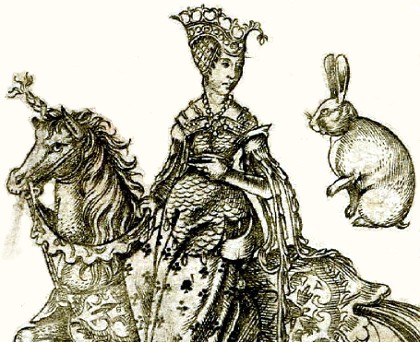
A pack of playing cards with five suits: roses, columbines, carnations, parrots and hares... everyday objects suggesting the natural world of life and fertility.
This pack of seventy-two round playing cards shows the artist in top creative form. The imagery depicts plants and animals based on the study of nature, rather than copied from artists' model books as previous engravers of cards had done (e.g. Master of the Playing Cards). Flowers are shown in various stages of bloom. The name of the engraver is unknown but he is known today as the Master P.W. due to his monogram.

The inscription “Salve Felix Colonia” (Hail, happy Cologne) accompanied by three crowns of the Cologne coat of arms on the title card confirms that the cards were made in Cologne. There are fourteen cards per suit: King, Queen, Upper and Lower Valet (or Squire and Man-at-Arms) and ten numerals, with Latin inscriptions on the Ace in each suit. The Kings and Queens are lavishly dressed figures on horseback (or a donkey). The detail includes embroidered brocade material and elaborate jewel adornments on the headgear and edges of the gowns. Even the horses have decorative livery and are depicted in anatomical detail. There are no references to religion but only to social class, costumes and nature.


Above: Master PW Circular Playing Cards (1499-1515 approx. dates of activity). The five suits, rather than the customary four, are: Hares, Parrots, Carnations (or Pinks), Columbines (or Aquilegias) and Roses. The total number of cards is 72; diameter = 70 mms (outer borderline). All seventy-two of Master PW's designs have survived in from one to six impressions, but no single repository owns a complete deck. Copies are preserved at: Bologna (sixty-nine cards) and Dresden (fifty-two); the British Museum, London; Vienna; Cologne, Rothchild Collection, Paris; Amsterdam and Boston. The British Museum makes its collection database available to be used by scholars across the world.
These playing cards were copied by Teleman de Wesel, the Lower Rhenish engraver (in reverse) although the suit of roses as well as all of the tens from Master PW's series were eliminated and substituted by four new under-knaves. The cards were also copied by the Cologne engraver, Johann Bussemacher (Cologne 1591) and Jacob Binck.

The engraving of lines in metal in order to print on paper developed from the goldsmith's long-established practice of decorating metal with engraved patterns. The technique was first used for printing on paper in the second quarter of the fifteenth century. It was considered the most noble and appropriate technique in which to render the work of great masters. Since none of Master PW's surviving cards are mounted on stiff card, the question arises whether they were actually intended for play. Although it is known that circular cards were used in India, the circular format was not the norm in the West. Of course, circular illustrations were known in the 15th & 16th centuries depicting occupations of the months and calendar illustrations. Likewise, naturalistic flowers, birds and animals occur in the borders of books of hours. We see here how the profane world of the medieval playing card had close connections with religious artwork.
“The extra card in which Death is clutching at a nude woman give these round cards the character of a series which was only intended for looking at. Having found pleasure in the sequence of roses, columbines, parrots, hares and pinks, having admired the ingenious arrangement of the flowers and animals and the quality of the draughtmanship, having smiled at the sometimes cranky kings, queens and knaves and having reflected on the slogans on the ace cards, one is reminded by the final card of the transitory nature of mortal beauty” [quoted from Detlef Hoffmann, 1973].
People are still superstitious today, but in the past they were more so. Cards would play a part in how they made sense of the world in an era when there were so many unexplained mysteries. They are more than just a pack of cards, people could read into the symbols and inscriptions, draw analogies, make decisions or find meaning in everyday life. The inscriptions on the five Aces are as follows:
Ace of Roses: “Pepulit Vires Casus Animo Qui Tulit Aequo” which translates as: “He defeats the power of chance who endures with equanimity”. • Ace of Aquilegias (Pinks): “Par Ille Superis cui Pariter Dies Et Fortuna Fuit”, which translates as: “He is equal to the gods who equally received time and fortune”. • Ace of Carnations: “Fortuna Opes Auferre Non Animum Potest”, which translates as: “Fortune can take away wealth but not fortitude”. • Ace of Hares: “Felix Media Quisquis Turbae Parte Quietus”, which translates as: “He is happy who is quiet in the middle of turmoil”. • Ace of Parrots: “Quicquid Facimus Venit Ex Alto”, which translates as: “Whatever we do comes from aloft”.

Above: in the rectangular version published by Lo Scarabeo, Turin, Italy (2004), the Aquilegia suit was omitted, the four Squires removed and two jokers added, so that modern games can be played.
A style of manuscript illumination during the high Gothic period, around the late 15th / early 16th century, involved decorating the margins with a luxurious array of strewn flowers, fruits, small animals and insects, painted in a naturalistic style on a gold background. In the example of a Missal shown below, the roundels in the borders also contain miniature illustrations of saints of the month, each accompanied by an appropriate symbol by which he may be recognised.
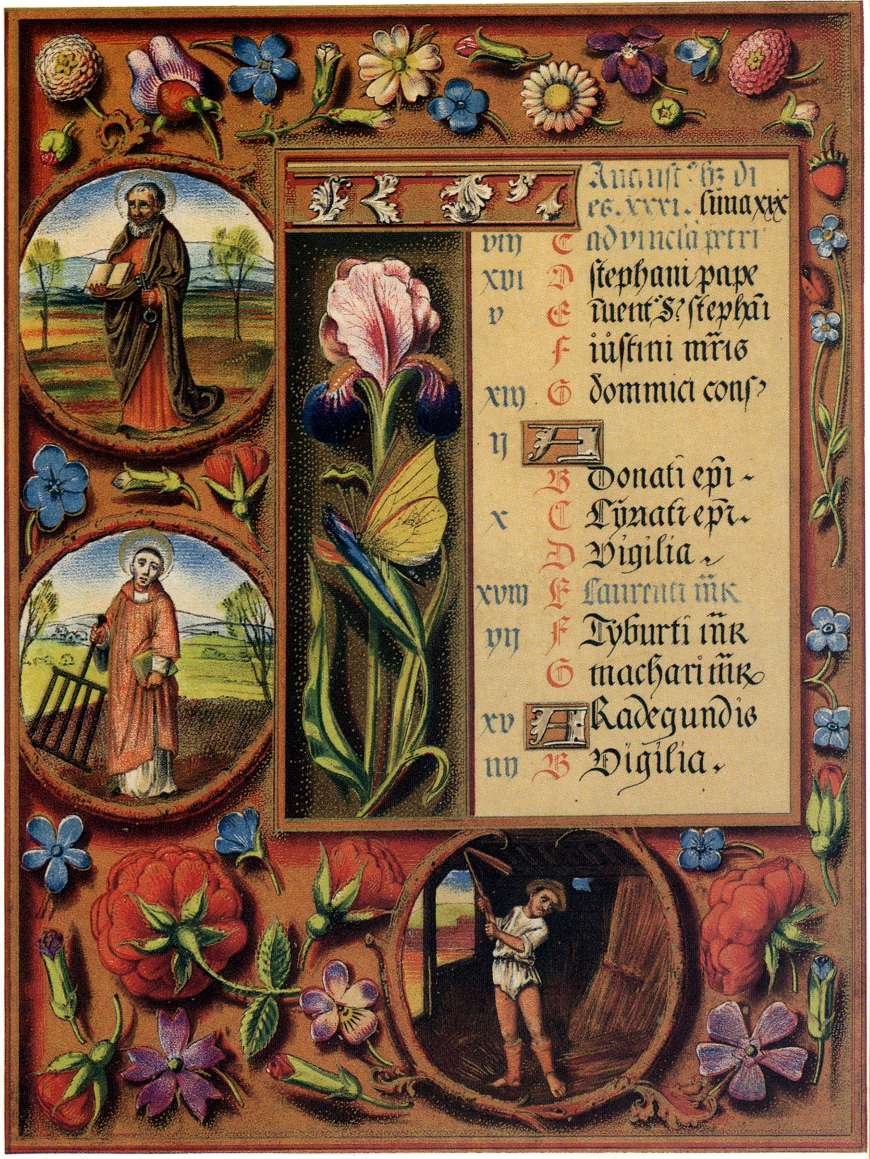
Above: Calendar page from an early sixteenth century missal, corresponding to the month of August, in the zodiac sign of Virgo, showing naturalistic strewn flowers in the borders, not unlike those used as suit symbols by the Master PW in his playing cards.
References:
Hoffmann, Detlef: The Playing Card, an illustrated history, Edition Leipzig, 1973
Humphreys, Henry Noel: The Illuminated Books of the Middle Ages, illustrated by Owen Jones, originally published in 1849, re-published by Bracken Books, London, 1989
V&A Museum, London

By Simon Wintle
Member since February 01, 1996
Founder and editor of the World of Playing Cards since 1996. He is a former committee member of the IPCS and was graphics editor of The Playing-Card journal for many years. He has lived at various times in Chile, England and Wales and is currently living in Extremadura, Spain. Simon's first limited edition pack of playing cards was a replica of a seventeenth century traditional English pack, which he produced from woodblocks and stencils.
Trending Articles
Popular articles from the past 28 days
Related Articles
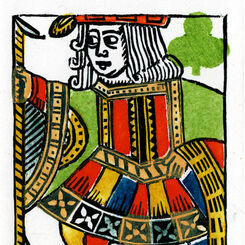
Woodblock and Stencil Jack of Clubs
A limited edition art print of the Jack of Clubs 1984 woodblock joker.
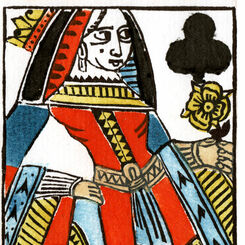
Woodblock and Stencil Queen of Clubs
A limited edition art print of the Queen of Clubs 1984 woodblock joker.
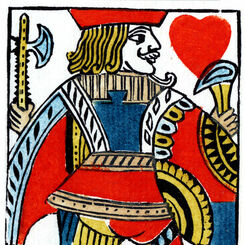
Woodblock and Stencil Jack of Hearts
A limited edition art print of the Jack of Hearts 1984 woodblock joker.
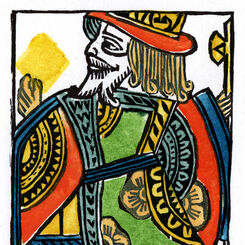
Woodblock and Stencil King of Diamonds
A limited edition art print of the King of Diamonds 1984 woodblock joker.
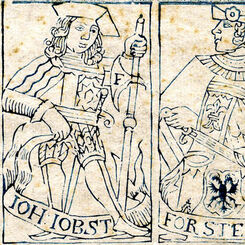
Uncut Sheet by Johann Jobst Forster
A proof sheet containing twelve court cards of conventional French type.
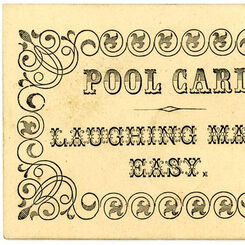
Laughing Made Easy
a Victorian card game published by D. Ogilvy.
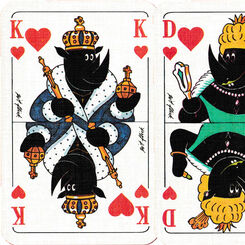
Mit Rhino auftrumpfen
Black rhinos on a publicity pack for Armstrong, a flooring company, with comic designs by Pit Flick....
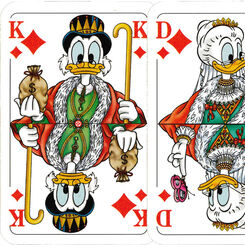
Walt Disney Cards II
Mickey, Minnie, Pluto and other familiar Disney characters.
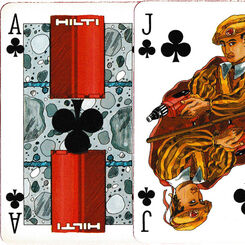
Hilti I
Promotional pack for Hilti power tools, with courts in medieval costume and non-standard pips.
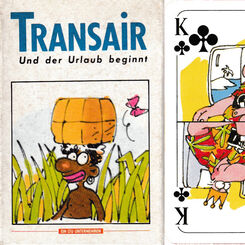
Transair
Humorous designs promoting Transair, a German charter flight operator.
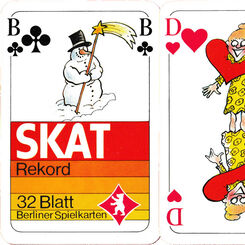
Merz Pharma Skat
Comic designs promoting Merz Pharma, a German drug company.
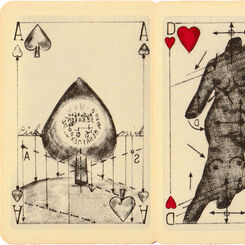
escART, ec-ART, SKAT
Fully illustrated pack printed from etchings by Johannes Vennekamp.
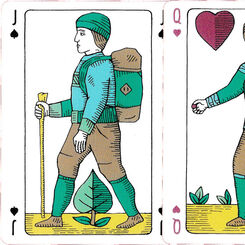
Commoners playing cards
Created by Ian Cumpstey dedicated to the common land and the countryside.
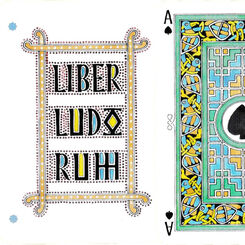
Liber Ludorum
Liber Ludorum playing cards created by Ian Cumpstey in the insular style, United Kingdom, 2019.
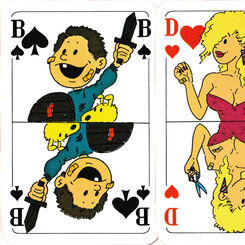
Hansaplast®
Advertising pack for Hansaplast, with comic courts sporting sticking plasters.
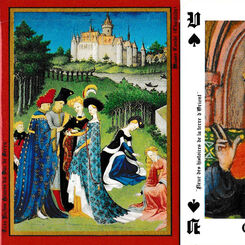
Jeu Gothique
‘Jeu Gothique’ illustrating the Gothic period in France, published by Editions Dusserre.
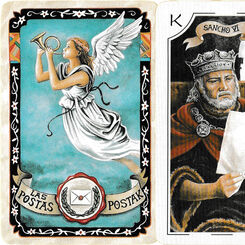
Postak – Las Postas
‘Postak - Las Postas’ playing cards commemorating the history of the Basque postal service, Spain, 1...
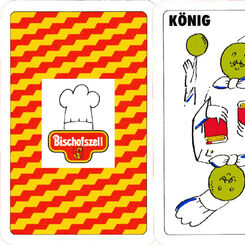
Bischofszell
Advertising pack for the food producer Bischofszell, designed by Heinz Looser-Brenner, with non-stan...
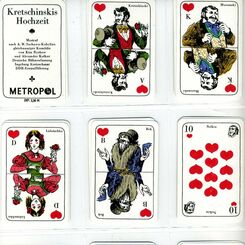
Wedding of Krechinsky • Свадьба Кречинского
A pack of cards depicting characters from the famous play "The Wedding of Krechinsky" by Sukhovo-Kob...
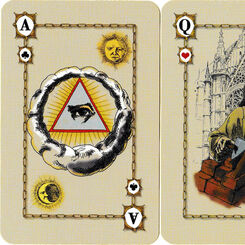
Freimaurer Spielkarten / Masonic playing cards
Masonic playing cards created by Ivan Wojnikow, 2004.
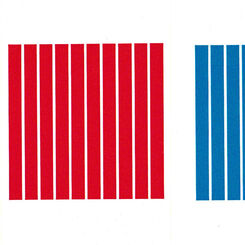
Marcello Morandini
Modern designs by Italian artist Marcello Morandini using the simplest of forms and colours.
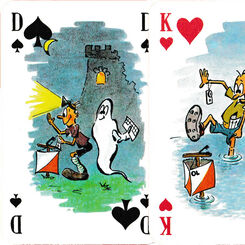
Orientierungslauf Skat
Humorous designs by Helmut Härtelt on the subject of orienteering.
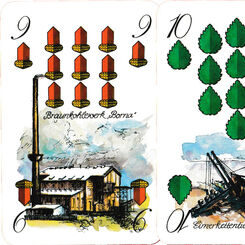
Borna Skat
Publicity pack for the Saxon town of Borna, with designs by Andreas Wachter.
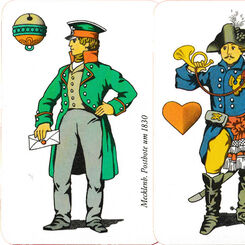
Postgeschichte
A celebration of different postal systems in Germany from 1630 to 1850, with designs by Volker Hartm...
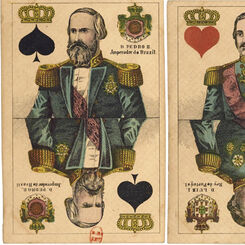
Kings and Queens of Brazil & Portugal
Historical playing cards by C. L. Wüst depicting monarchs of Brazil and Portugal.
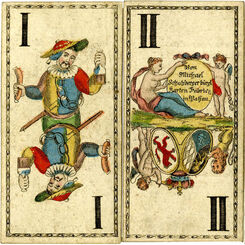
Mythological tarot by Michael Schatzberger
Mythological tarot by Michael Schatzberger, Passau, Bavaria, early 19th century.
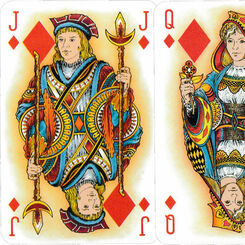
Tavaglione playing cards
Well-designed pack by Giorgio Tavaglione, with courts in medieval costume.
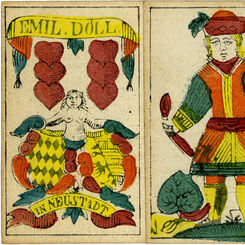
Ansbach pattern by Emil Doll
Later Ansbach or Nürnberg pattern by Emil Doll, Neustadt.
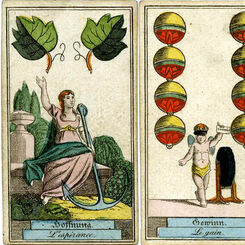
Cartomancy deck by Johann Ernst Backofen
German-suited Cartomancy deck published by Johann Ernst Backofen, Nürnberg.
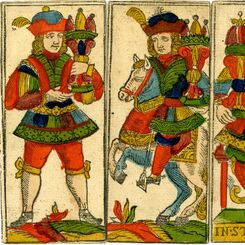
Trappola pack by Joseph Fetscher
Trappola pack published by Joseph Fetscher, Graz, 1739.
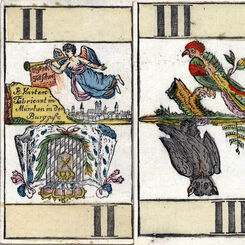
Animal Tarot by Joseph Fetscher
French-suited Natural History Tarot deck by Joseph Fetscher, Munich, c.1820.
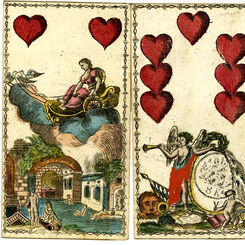
Heathen Wars
German-suited ‘Heathen War’ playing cards published by Joseph Fetscher, Munich, c.1820.
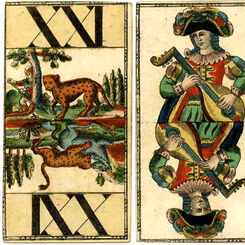
Mythological and Allegorical tarot
Mythological and Allegorical tarot produced by Peter Paul Fetscher junior, Munich.
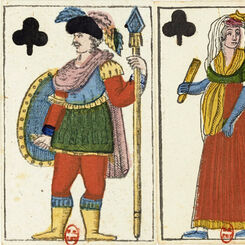
Fantasy deck by Joseph Fetscher
Fantasy French-suited pack produced by Joseph Fetscher, Munich, c.1825.
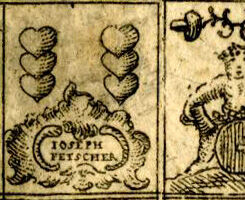
Miniature playing cards by Joseph Fetscher
Uncut sheet of miniature Bavarian playing cards by Joseph Fetscher.
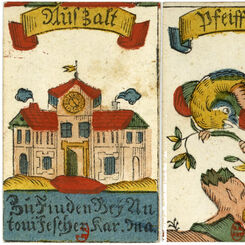
Vogelspiel
Vogelspiel, a German card game known as the “cuckoo game” also known as “Gnau”.
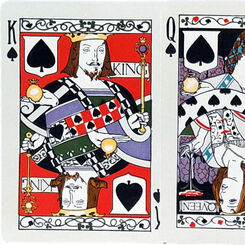
Mediaeval Playing Cards
Finely executed late 19th century pack from the USA featuring courts in medieval costume.
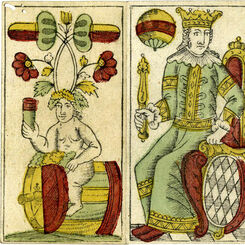
Bavaria pattern
Classic German-suited Bavarian pattern by Joseph Fetscher, Munich, early 19th century.
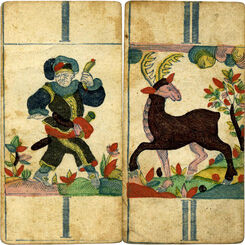
Animal Tarot by Andreas Benedict Göbl
French-suited Animal Tarot deck produced by Andreas Benedict Göbl, Munich.
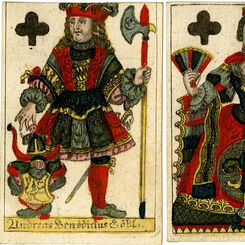
Standard French-suited Bavarian deck by Göbl
French-suited Bavarian deck by Andreas Benedict Göbl, late 18th c.
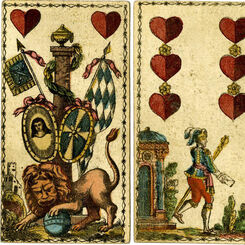
Historical playing cards by Joseph Fetscher
Historical playing cards by Joseph Fetscher, Munich, c.1820.
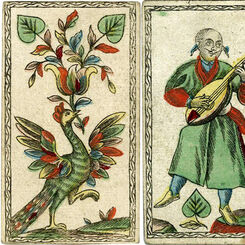
Illustrated piquet cards
Bavarian piquet cards with oriental illustrations produced by Andreas Benedict Göbl, Munich, late 18...
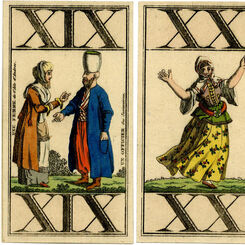
Costumes of Turkey Tarot
‘National Costumes of Turkey’ tarot by Industrie Comptoir, Leipzig, c.1800-1825.
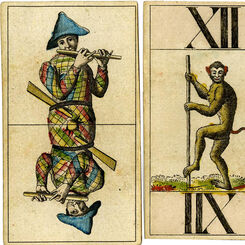
Natural History Tarot
Natural History Tarot published by G M, Germany, early 19th C.


